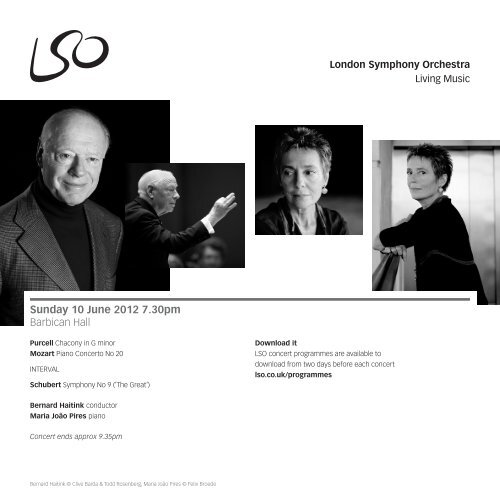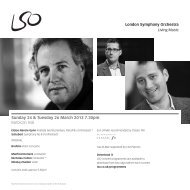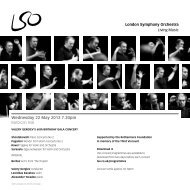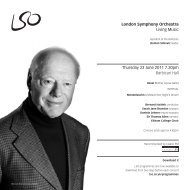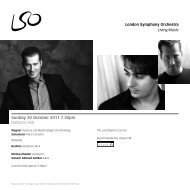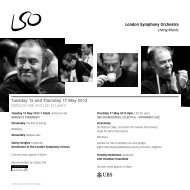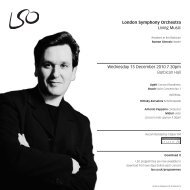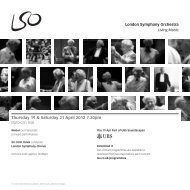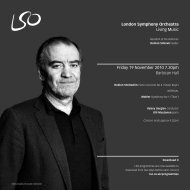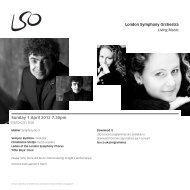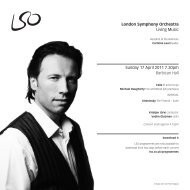Sunday 10 June 2012 - London Symphony Orchestra
Sunday 10 June 2012 - London Symphony Orchestra
Sunday 10 June 2012 - London Symphony Orchestra
You also want an ePaper? Increase the reach of your titles
YUMPU automatically turns print PDFs into web optimized ePapers that Google loves.
<strong>Sunday</strong> <strong>10</strong> <strong>June</strong> <strong>2012</strong> 7.30pm<br />
Barbican Hall<br />
Purcell Chacony in G minor<br />
Mozart Piano Concerto No 20<br />
INTERVAL<br />
Schubert <strong>Symphony</strong> No 9 (‘The Great’)<br />
Bernard Haitink conductor<br />
Maria João Pires piano<br />
Concert ends approx 9.35pm<br />
Bernard Haitink © Clive Barda & Todd Rosenberg, Maria João Pires © Felix Broede<br />
Download it<br />
LSO concert programmes are available to<br />
download from two days before each concert<br />
lso.co.uk/programmes<br />
<strong>London</strong> <strong>Symphony</strong> <strong>Orchestra</strong><br />
Living Music
Welcome News<br />
Welcome to this evening’s LSO concert at the Barbican, the first of two<br />
concerts which reunite conductor Bernard Haitink with pianist Maria<br />
João Pires, who last performed with the <strong>Orchestra</strong> in <strong>June</strong> 2011.<br />
Bernard Haitink has a rich history with the LSO and is one of the<br />
<strong>Orchestra</strong>’s most loved guest conductors. Into the <strong>2012</strong>/13 season,<br />
the LSO looks forward to working with Haitink to present works by<br />
Britten, Mozart, Beethoven and Bruckner across three concerts in<br />
February 2013 (see page 5 for more details). Maria João Pires has<br />
had a highly successful season across Europe and will be joining<br />
Bernard Haitink on tour with the <strong>Orchestra</strong> to perform tonight’s<br />
programme, and the programme for 14 <strong>June</strong>, at Salle Pleyel in Paris<br />
on 17 and 18 <strong>June</strong>.<br />
I hope you enjoy tonight’s concert and can join us for our next<br />
performance on Thursday 14 <strong>June</strong> when Bernard Haitink and<br />
Maria João Pires will join forces once more for Mozart’s Piano<br />
Concerto No 23, alongside Purcell’s Funeral Music for Queen Mary<br />
and Bruckner’s lyrical <strong>Symphony</strong> No 7.<br />
Kathryn McDowell<br />
LSO Managing Director<br />
Sir Colin Davis awarded Order of the Dannebrog<br />
Congratulations to LSO President Sir Colin Davis, who was bestowed<br />
with a Commander of the Order of the Dannebrog on Friday 25 May.<br />
The decoration is presented to those who make a special contribution<br />
to the public, the arts and sciences in Denmark, and is one of the<br />
oldest orders in existence. Sir Colin Davis was honoured this for his<br />
recordings of Nielsen’s symphonies, recorded with the LSO in 2011.<br />
The award was presented at a ceremony at the Danish Embassy<br />
hosted by the Danish Ambassador, Ms Anne Hedensted Steffensen.<br />
lso.co.uk<br />
City of <strong>London</strong> Festival<br />
The City is alive with culture this summer and the LSO is delighted<br />
to be taking part in a highlight of the City’s cultural calendar: the<br />
50th anniversary of the City of <strong>London</strong> Festival (24 <strong>June</strong> to 27 July).<br />
The LSO’s contribution comes in the form of two performances<br />
of Berlioz’s Requiem at St Paul’s Cathedral under Sir Colin Davis<br />
(Monday 25 and Tuesday 26 <strong>June</strong>). In addition, there is also an<br />
independent four-day Celebrate the City event, Four Days in the<br />
Square Mile from 21 to 24 <strong>June</strong>.<br />
colf.org and visitthecity.co.uk/culture<strong>2012</strong><br />
<strong>London</strong> <strong>2012</strong><br />
As part of the <strong>London</strong> <strong>2012</strong> celebrations, the LSO will also perform<br />
in three special concerts in association with the Barbican, the first<br />
with South American singer-songwriter Gilberto Gil and conductor<br />
François-Xavier Roth (4 July), then on 21 July award-winning composer<br />
and producer Nitin Sawhney will conduct the <strong>Orchestra</strong> in his newly<br />
written score for Hitchcock’s film The Lodger, and finally on 25 and<br />
26 July jazz trumpeter Wynton Marsalis joins Sir Simon Rattle and the<br />
LSO with Jazz at Lincoln Center <strong>Orchestra</strong> for two concerts featuring<br />
the UK premiere of Marsalis’ Swing <strong>Symphony</strong>.<br />
lso.co.uk/whatson<br />
2 Welcome & News Kathryn McDowell © Camilla Panufnik
Henry Purcell (1659–95) arr Benjamin Britten<br />
Chacony in G minor (date unknown)<br />
‘Chacony’ is an idiosyncratic English spelling of the French<br />
‘Chaconne’, the term applied to a triple-time dance movement in<br />
which a short bass-line theme or chord progression is repeated a<br />
number of times while other instruments or voices spin variations<br />
over the top. The practice – whether applied to a ‘ciacona’ or other<br />
popular basses such as the bergamasca or a follia – had its origins<br />
in improvised dance music, but found its way into many genres<br />
of instrumental music during the 16th and 17th centuries, from<br />
Elizabethan keyboard pieces to Italian violin sonatas, to the orchestral<br />
chaconnes which traditionally appeared towards the end of French<br />
operas. This last is perhaps the most pertinent model for a piece like<br />
Purcell’s G minor Chacony for three (probably solo) violins and basso<br />
continuo, though it is not known exactly when and why he composed it.<br />
Purcell’s own assessment of composing ‘upon a ground’ (as the<br />
English called it) was that it was ‘a very easie thing to do, and requires<br />
but little Judgement’, but that rather belies the evidence of such well-<br />
known examples as ‘Dido’s Lament’ from the opera Dido and Aeneas<br />
or the song ‘Music for a while’ that he was a master of the genre,<br />
able to balance with perfect naturalness the competing demands<br />
of variational freedom and repetitive continuity. Yet the Chacony is<br />
more than just an exercise in craftsmanship; with its elegant minor-<br />
key melancholy and typically rich Purcellian inner part-writing, it is a<br />
powerfully affecting snapshot of its composer’s artistic personality.<br />
Benjamin Britten, one of the 20th century’s most influential lovers of<br />
Purcell, admired it for its ‘mixture of clarity, brilliance, tenderness and<br />
strangeness’ and made his sympathetic realisation of it for modern<br />
string orchestra in 1948.<br />
Programme Note © Lindsay Kemp<br />
Lindsay Kemp is a senior producer for BBC Radio 3, Artistic Director<br />
of the Lufthansa Festival of Baroque Music, and a regular contributor<br />
to Gramophone magazine.<br />
Henry Purcell (1659–95)<br />
Composer Profile<br />
Henry Purcell was born, married, fathered six children of whom only<br />
two made it past infancy, and died just a stone’s throw away from<br />
Westminster Abbey.<br />
Following his father’s death in 1664, Purcell was placed in the care of<br />
his uncle, Thomas Purcell, who was a Gentleman of the Chapel Royal<br />
where Purcell duly became a chorister until his voice broke in 1673.<br />
Purcell received tuition from John Blow, who later passed on his office<br />
as organist of Westminster Abbey to Purcell in 1679, a position which<br />
Purcell also held in conjunction with being organist at the Chapel Royal<br />
from 1682. Purcell is thought to have been composing from just nine<br />
years of age but his earliest certified work was an ode for the King’s<br />
birthday in 1670. Purcell quickly developed a reputation for his choral<br />
works, most notably the anthems I was glad and My heart is inditing<br />
for the coronation of James II in 1685 and Come ye Sons of Art, a<br />
gloriously elaborate birthday ode for Queen Mary. Purcell’s Te Deum<br />
and Jubilate Deo were written for St Cecilia’s Day in 1693 and was the<br />
first English Te Deum ever composed with orchestral accompaniment.<br />
Purcell also had a long-standing association with the theatre,<br />
composing music for The Fairy-Queen (an adaptation of Shakespeare’s<br />
A Midsummer Night’s Dream) and by far his most famous dramatic<br />
output, Dido and Aeneas, as well as incidental music for Shakespeare’s<br />
The Tempest and Robert Howard’s The Indian Queen, for which<br />
Purcell’s younger brother Daniel completed much of the music for<br />
the final act after Purcell’s death.<br />
Purcell died a successful and wealthy, albeit young, man in 1695.<br />
Many theories have circulated around the circumstances of his death<br />
but the most prevalent are that he either caught a chill after finding<br />
himself locked out of the house by his wife or that he contracted<br />
tuberculosis. Purcell was buried adjacent to the organ in Westminster<br />
Abbey where his epitaph reads, ‘Here lyes Henry Purcell Esq, who left<br />
this life and is gone to that blessed place where only his harmony can<br />
be exceeded’.<br />
Programme Notes<br />
3
Wolfgang Amadeus Mozart (1756–91)<br />
Piano Concerto No 20 in D minor, K466 (1785)<br />
1 Allegro<br />
2 Romance<br />
3 Rondo: Allegro assai<br />
Maria João Pires piano<br />
The decade which Mozart spent in Vienna from 1781 until his death<br />
was when he truly found his own voice as a composer, and nowhere<br />
is this new maturity and individuality better shown than in his piano<br />
concertos of the period. Altogether he wrote 17 of them while in the<br />
Imperial capital, mostly for himself to play at the public and private<br />
concerts which helped provide him with financial support, and as such<br />
they were the works with which he was most closely associated by his<br />
audiences. More importantly, it was with them that he established the<br />
piano concerto for the first time as a sophisticated means of personal<br />
expression rather than a vehicle for polite public display.<br />
The high-point in the series came with the five concertos composed<br />
in the period of just over a year from the beginning of 1785. K466 –<br />
completed and first performed in February 1785 – is chronologically<br />
at the head of this group, but musically speaking it also stands out<br />
in many ways. The composer’s father Leopold, visiting Vienna at the<br />
time, heard the premiere, and a little over a year later was organising<br />
a performance by a local pianist back in Salzburg. He later described<br />
the occasion in a letter to his daughter: ‘Marchand played it from<br />
the score, and [Michael, brother of Joseph] Haydn turned over the<br />
pages for him, and at the same time had the pleasure of seeing with<br />
what art it is composed, how delightfully the parts are interwoven<br />
and what a difficult concerto it is. We rehearsed it in the morning and<br />
had to practise the rondo three times before the orchestra could<br />
manage it’. One can well imagine the impression the piece made in<br />
the composer’s home town; there can be few clearer demonstrations<br />
of how far he had left Salzburg behind. D minor is a relatively unusual<br />
key for Mozart, and therefore a significant one. Later he would use it<br />
both for Don Giovanni’s damnation scene and for the Requiem, and<br />
there is something of the same grim familiarity with the dark side,<br />
a glimpse of the grave it seems, in the first movement of this concerto.<br />
4 Programme Notes<br />
The opening orchestral section contrasts brooding menace with<br />
outbursts of passion, presenting along the way most of the melodic<br />
material that will serve the rest of the movement. Even so, it is with a<br />
new theme, lyrical but searching and restless, that the piano enters;<br />
this is quickly brushed aside by the orchestra, but the soloist does not<br />
give it up easily, later using it to lead the orchestra through several<br />
different keys in the central development section. The movement<br />
ends sombrely, pianissimo.<br />
The slow second movement, in B-flat major, is entitled ‘Romance’,<br />
a vague term used in Mozart’s day to suggest something of a song-<br />
like quality. In fact this is a rondo, in which three appearances of the<br />
soloist’s artless opening theme are separated by differing episodes,<br />
the first a drawn-out melody for the piano floating aristocratically<br />
over gently throbbing support from the strings, and the second a<br />
stormy minor-key eruption of piano triplets, shadowed all the way by<br />
sustained woodwind chords. Storminess returns in the finale, though<br />
this time one senses that it is of a more theatrical kind than in the<br />
first movement. This is another rondo, and although the main theme<br />
is fiery and angular, much happens in the course of the movement to<br />
lighten the mood, culminating after the cadenza in a turn to D major<br />
for the concerto’s final pages. A purely conventional ‘happy ending’<br />
to send the audience away smiling? Perhaps so, but the gentle<br />
debunking indulged in by the horns and trumpets just before the end<br />
suggests that Mozart knew precisely what he was doing.<br />
Programme Note © Lindsay Kemp<br />
Music’s better shared!<br />
The LSO offers great benefits for groups of <strong>10</strong>+ including 20% off<br />
standard ticket prices, priority booking, free interval hot drinks and,<br />
for bigger groups, the chance of a private interval reception.<br />
To reserve tickets, call the dedicated Group Booking line on<br />
020 7382 7211. If you have general queries, please call LSO Groups<br />
Rep Fabienne Morris on 020 7382 2522. Tonight we welcome:<br />
Shirley Arber & Friends, Classical Partners, Farnham U3a<br />
Concert Club, Faversham Music Club, Dan Petersen &<br />
Friends, Redbridge & District U3a and Frances Sell & Friends
Wolfgang Amadeus Mozart (1756–91)<br />
Composer Profile<br />
Born in Salzburg on 27 January 1756, Mozart began to pick out<br />
tunes on his father’s keyboard before his fourth birthday. His first<br />
compositions, an Andante and Allegro for keyboard, were written<br />
down in the early months of 1761; later that year, the boy performed<br />
in public for the first time at the University of Salzburg. Mozart’s<br />
ambitious father, Leopold, court composer and Vice-Kapellmeister<br />
to the Prince-Archbishop of Salzburg, recognised the money-making<br />
potential of his precocious son and pupil, embarking on a series of<br />
tours to the major courts and capital cities of Europe.<br />
In 1777 Wolfgang, now 21 and frustrated with life as a musician-in-<br />
service at Salzburg, left home, visiting the court at Mannheim on<br />
the way to Paris. The Parisian public gave the former child prodigy a<br />
lukewarm reception, and he struggled to make money by teaching<br />
and composing new pieces for wealthy patrons. A failed love affair<br />
and the death of his mother prompted Mozart to return to Salzburg,<br />
where he accepted the post of Court and Cathedral Organist.<br />
In 1780 he was commissioned to write an opera, Idomeneo, for the<br />
Bavarian court in Munich, where he was treated with great respect.<br />
The servility demanded by his Salzburg employer finally provoked<br />
Mozart to resign in 1781 and move to Vienna in search of a more<br />
suitable position, fame and fortune. In the last decade of his life, he<br />
produced a series of masterpieces in all the principal genres of music,<br />
including the operas The Marriage of Figaro (1785), Don Giovanni<br />
(1787), Così fan tutte and The Magic Flute, the Symphonies Nos 40<br />
and 41 (‘Jupiter’), a series of piano concertos, a clarinet quintet and<br />
the Requiem, left incomplete at his death on 5 December 1791.<br />
Composer Profile © Andrew Stewart<br />
INTERVAL: 20 minutes<br />
<strong>London</strong> <strong>Symphony</strong> <strong>Orchestra</strong><br />
Bernard Haitink & Maria João Pires<br />
this season and next with the LSO<br />
Thu 14 Jun <strong>2012</strong><br />
Purcell arr Steven Stucky<br />
Funeral Music for Queen Mary<br />
Mozart Piano Concerto No 23<br />
Bruckner <strong>Symphony</strong> No 7<br />
Bernard Haitink conductor<br />
Maria João Pires piano<br />
Supported by LSO Patrons<br />
Box Office<br />
020 7638 8891 (bkg fee)<br />
lso.co.uk (reduced bkg fee)<br />
Tue 12 Feb 2013<br />
Britten Four Sea Interludes<br />
Mozart Piano Concerto No 21<br />
Beethoven <strong>Symphony</strong> No 7<br />
Bernard Haitink conductor<br />
Maria João Pires piano<br />
Sun 17 & Thu 21 Feb 2013<br />
Mozart Piano Concerto No 17<br />
Bruckner <strong>Symphony</strong> No 9<br />
Bernard Haitink conductor<br />
Maria João Pires piano<br />
21 Feb supported by LSO Premier<br />
Programme Notes<br />
5
Franz Schubert (1797–1828)<br />
<strong>Symphony</strong> No 9 in C major (‘The Great’) D944 (1825, rev 1826)<br />
1 Andante – Allegro ma non troppo<br />
2 Andante con moto<br />
3 Scherzo: Allegro vivace<br />
4 Finale: Allegro vivace<br />
It is not clear when people first began referring to Schubert’s last<br />
completed symphony as the ‘Great C major’. Apparently the tag was<br />
first applied to differentiate it from the ‘little’ C major symphony,<br />
known as ‘No 6’, which Schubert wrote in 1817–18. But the nickname<br />
is well deserved: apart from Mozart’s ‘Jupiter’ it is the great <strong>Symphony</strong><br />
in C. Not only is it conceived on a huge scale, its sophistication and<br />
formal mastery are as impressive as its vitality, imaginative range and<br />
the infectious memorability of its main themes.<br />
That mastery is all the more impressive when one considers that it<br />
was only the year before he began work on the score that Schubert<br />
had declared his intention in a letter ‘to pave my way to grand<br />
symphony’. That same year, 1824, Schubert had also heard the<br />
premiere of Beethoven’s ‘Choral’ Ninth – a big influence to digest,<br />
one might have thought, and yet Schubert’s response to that<br />
challenge is confident and utterly original. Indeed Schubert clearly<br />
felt so sure of himself that he was able to invoke Beethoven’s Ninth<br />
without fear of comparison: the woodwind figures at the beginning of<br />
the development section of Schubert’s finale contain an unmistakable<br />
reference to a phrase from Beethoven’s famous ‘Ode to Joy’ theme.<br />
Almost certainly the C major <strong>Symphony</strong>’s vigour and assurance reflect<br />
something of Schubert’s mood in the summer of 1825, when he made<br />
a long walking tour with friends in Upper Austria. At one point in that<br />
extended holiday the party stayed at the house of Anton Ottenwalt,<br />
brother-in-law of Schubert’s close friend Josef von Spaun. Ottenwalt<br />
wrote that ‘Schubert looks so well and strong, is so bright and relaxed,<br />
so genial and communicative, that one cannot but be sincerely<br />
delighted’. In the next sentence, Ottenwalt reports that Schubert<br />
‘had been working on a symphony … which is to be performed in<br />
Vienna this winter’. For Ottenwalt there was clearly a connection<br />
between Schubert’s state of mind and his current musical fertility.<br />
6 Programme Notes<br />
But one could go further than that. The symphony is dominated<br />
by images of physical movement: the muscular, striding theme of<br />
the first movement; the exuberant waltz-tunes of the Scherzo; the<br />
hurtling vitality of the Finale – even the ‘slow’ second movement<br />
is carried forward by a march-like tread, introduced on the strings<br />
before the oboe sounds the leading melody. It is hard to imagine a<br />
greater contrast with the lyrical, introverted character of the B minor<br />
‘Unfinished’ <strong>Symphony</strong>, composed in much less happy times three<br />
years earlier. It is surely also significant that that productive summer<br />
of 1825 saw the completion of one of Schubert’s most awe-inspiring<br />
songs, a hymn to the God revealed in nature entitled ‘Die Allmacht’<br />
(Omnipotence) – also in C major and, like the finale of the new<br />
symphony, dominated by repeated triplet rhythms. An invigorating<br />
walking regime, a delight in nature, thoughts of God inspired by sublime<br />
landscapes – all of this is implicit in the ‘Great’ C major <strong>Symphony</strong>.<br />
Despite his excellent spirits and abundant inspiration, Schubert had to<br />
wrestle with the symphony before it arrived at its final form. The score<br />
was extensively revised in 1826, as a result of which it became even<br />
longer than that already ambitious first version. Finally the symphony<br />
was handed over to the Vienna Philharmonic Society; parts were<br />
duly copied, and at some time towards the end of 1826 there was a<br />
run-through by the orchestra. But the hoped-for public performance<br />
did not materialise. According to one account, the symphony was<br />
‘provisionally put aside, because of its length and difficulty’. Schubert<br />
was never to hear the work performed in concert. It wasn’t until March<br />
1839 – eleven years after the composer’s death – that Mendelssohn<br />
conducted it at the Leipzig Gewandhaus. And despite enthusiastic<br />
championship, especially by the composer Robert Schumann –<br />
who made a point of praising its ‘heavenly length’ – it was not widely<br />
recognised as the masterpiece it is until much later. Even well into<br />
the 20th century it was not uncommon for the symphony to be<br />
performed with cuts.<br />
It is obvious from the opening bars that this is to be a symphonic<br />
journey on a grand scale. Two horns, unaccompanied, announce a<br />
quietly majestic tune that is to find echo in many of the symphony’s<br />
later ideas. Instead of providing a conventional classical ‘slow
introduction’ the substantial Andante first section is more in the<br />
nature of a set of free variations on the horns’ melody, building<br />
steadily to a powerful full-orchestral climax, at which the main Allegro<br />
ma non troppo theme (clearly alluding to the horns’ final phrase)<br />
sweeps in. Later, after the gentler second theme (woodwinds),<br />
trombones take another phrase from the horn melody and develop it<br />
in a thrilling long crescendo – one of the passages Schubert added in<br />
his revision of 1826. The first movement concludes with two impressive<br />
restatements of the horn tune in a new, condensed form: the journey<br />
has come full circle, but the perspective has changed radically.<br />
The following Andante con moto leads off at a walking pace – the<br />
kind of measured, almost hypnotic tread one encounters in several<br />
of Schubert’s later songs and chamber works. There are stiller,<br />
reflective, mysterious passages, but it is the march movement that<br />
provokes the movement’s astonishing climax: a huge fff (extremely<br />
loud) dissonance followed by an awe-struck silence – not everything<br />
in this symphony is joyous or good-humoured. The Scherzo is an<br />
elemental symphonic waltz: Schubert was clearly impressed by the<br />
scale of the scherzo of Beethoven’s Ninth, but responded with a<br />
kind of movement that is entirely personal – at no point inhibited by<br />
Beethoven’s gigantic shadow.<br />
For sustained drive and soaring intensity the Finale is unparalleled.<br />
The writer Donald Francis Tovey described the second theme as having<br />
‘the momentum of a planet in its orbit’, but the description could<br />
just as well apply to the movement as a whole. The final crescendo<br />
is electrifying, culminating in massive pounding unison Cs – perhaps<br />
Schubert was thinking of the statue of the Commendatore knocking at<br />
the door in Mozart’s Don Giovanni. Whatever the case, it adds a note<br />
of ambiguity to the symphony’s final pages. Joy or terror? As so often<br />
in the later Schubert, the exhilaration also leaves room for doubt.<br />
Programme Note © Stephen Johnson<br />
Stephen Johnson is the author of Bruckner Remembered (Faber). He<br />
also contributes regularly to the BBC Music Magazine, and broadcasts<br />
for BBC Radio 3 (Discovering Music), Radio 4 and the World Service.<br />
Franz Schubert (1797–1828)<br />
Composer Profile<br />
In childhood, Schubert was taught violin by his schoolmaster father<br />
and piano by his eldest brother. He rapidly became more proficient<br />
than his teachers, and showed considerable musical talent, so<br />
much so that in 1808 he became a member of Vienna’s famous<br />
Imperial Court chapel choir. He was educated at the Imperial City<br />
College, where he received lessons from the composer Salieri. His<br />
father, eager that Franz should qualify as a teacher and work in the<br />
family’s schoolhouse, encouraged the boy to return home in 1814.<br />
Compositions soon began to flow, although teaching duties interrupted<br />
progress. Despite his daily classroom routine, Schubert managed<br />
to compose 145 songs in 1815, together with four stage works, two<br />
symphonies, two Masses and a large number of chamber pieces.<br />
Though the quantity of Schubert’s output is astonishing enough,<br />
it is the quality of his melodic invention and the richness of his<br />
harmonic conception that are the most remarkable features of his<br />
work. He was able to convey dramatic images and deal with powerful<br />
emotions within the space of a few bars, as he so often did in his<br />
songs and chamber works. The public failure of his stage works<br />
and the reactionary attitudes to his music of conservative Viennese<br />
critics did not restrict his creativity, nor his enjoyment of composition;<br />
illness, however, did affect his work and outlook. In 1824 Schubert<br />
was admitted to Vienna’s General Hospital for treatment for syphilis.<br />
Although his condition improved, he suffered side-effects from his<br />
medication, including severe depression. During the final four years<br />
of his life, Schubert’s health declined; meanwhile, he created some<br />
of his finest compositions, chief among which are the song-cycles<br />
Winterreise and Schwanengesang, and the last piano sonatas.<br />
Composer Profile © Andrew Stewart<br />
Programme Notes<br />
7
Bernard Haitink<br />
Conductor<br />
‘On a night such as this,<br />
the <strong>London</strong> <strong>Symphony</strong><br />
<strong>Orchestra</strong> seems to be<br />
a confederacy of virtuosos’<br />
The Evening Standard on Haitink and the LSO<br />
With an international conducting career<br />
that has spanned more than five and a half<br />
decades, Amsterdam-born Bernard Haitink is<br />
one of today’s most celebrated conductors.<br />
Bernard Haitink was Chief Conductor of the<br />
Royal Concertgebouw <strong>Orchestra</strong> for 27 years<br />
and is now their Conductor Laureate. In<br />
addition, Haitink has previously held posts<br />
as Music Director of the Royal Opera, Covent<br />
Garden, Glyndebourne Festival Opera,<br />
the Dresden Staatskapelle, and Principal<br />
Conductor of the Chicago <strong>Symphony</strong><br />
<strong>Orchestra</strong> and the <strong>London</strong> Philharmonic.<br />
He is Conductor Emeritus of the Boston<br />
<strong>Symphony</strong> <strong>Orchestra</strong>. He has made frequent<br />
guest appearances with most of the world’s<br />
leading orchestras.<br />
Bernard Haitink began the 2011/12 season<br />
with the Chicago <strong>Symphony</strong> <strong>Orchestra</strong> and<br />
the New York Philharmonic, to which he<br />
returned for the first time in over 30 years.<br />
February <strong>2012</strong> saw the conclusion of a<br />
Beethoven Cycle with the Chamber <strong>Orchestra</strong><br />
of Europe in the Concertgebouw, Amsterdam,<br />
and the Salle Pleyel, Paris. Other highlights of<br />
2011/12 included the Christmas Day concert<br />
with the Royal Concertgebouw <strong>Orchestra</strong><br />
and engagements with the symphony<br />
orchestra of the Bayerischer Rundfunk and<br />
the Tonhalle <strong>Orchestra</strong>, as well as a three<br />
week residency with the Boston <strong>Symphony</strong>.<br />
Haitink brings the season to a close with<br />
concerts in <strong>London</strong> and Paris with the <strong>London</strong><br />
<strong>Symphony</strong> <strong>Orchestra</strong>, and in the Proms,<br />
Salzburg and Lucerne Festivals with the<br />
Vienna Philharmonic.<br />
Bernard Haitink has recorded widely for Phillips,<br />
Decca and EMI with the Concertgebouw<br />
<strong>Orchestra</strong>, the Berlin and Vienna Philharmonic<br />
orchestras and the Boston <strong>Symphony</strong> <strong>Orchestra</strong>.<br />
His discography also includes many opera<br />
recordings with the Royal Opera, Glyndebourne,<br />
the Bavarian Radio <strong>Orchestra</strong> and Dresden<br />
Staatskapelle. Most recently he has recorded<br />
extensively with the <strong>London</strong> <strong>Symphony</strong><br />
<strong>Orchestra</strong> for LSO Live, including the complete<br />
Brahms and Beethoven symphonies, and with<br />
the Chicago <strong>Symphony</strong> on their Resound<br />
label. Haitink’s recording of Janáček s Jenu˚ fa<br />
with the Royal Opera received a Grammy Award<br />
for best opera recording in 2004, and his<br />
Shostakovich <strong>Symphony</strong> No 4 recording with<br />
the Chicago <strong>Symphony</strong> was awarded a Grammy<br />
for Best <strong>Orchestra</strong>l Performance of 2008.<br />
Bernard Haitink has received many<br />
international awards in recognition of his<br />
services to music, including both an honorary<br />
Knighthood and the Companion of Honour in<br />
the United Kingdom, and the House Order of<br />
Orange-Nassau in the Netherlands. He was<br />
named Musical America’s Musician of the<br />
Year for 2007.<br />
8 The Artists Bernard Haitink © Clive Barda
Maria João Pires<br />
Piano<br />
‘Pires doesn’t pull phrases<br />
about yet her playing has<br />
infinite flexibility ... there was<br />
a real sense of conversation’<br />
The Evening Standard on Pires and the LSO<br />
One of the finest musicians of her generation,<br />
Maria João Pires continues to transfix<br />
audiences with the spotless integrity,<br />
eloquence, and vitality of her art.<br />
She was born on 23 July 1944 in Lisbon and<br />
gave her first public performance in 1948.<br />
In Portugal she studied with Campos Coelho<br />
and Francine Benoit, later continuing her studies<br />
in Germany with Rosl Schmid and Karl Engel.<br />
Since 1970 she has dedicated herself to<br />
reflecting on the influence of art on life,<br />
community and education, and in trying<br />
to develop new ways of implementing<br />
pedagogic theories within society. In the last<br />
<strong>10</strong> years she has held many workshops with<br />
students from all round the world, and has<br />
taken her philosophy and teaching to Japan,<br />
Maria João Pires © Felix Broede<br />
Brazil, Portugal, France, and Switzerland. In<br />
2005 she formed an experimental theatre,<br />
dance and music group, Art Impressions,<br />
and together they have produced two major<br />
projects – Transmissions and Schubertiade.<br />
In <strong>2012</strong>, in addition to her chamber music<br />
recitals with the Brazilian cellist Antonio<br />
Meneses, she appears with all the major<br />
European orchestras under the batons<br />
of Bernard Haitink, Claudio Abbado and<br />
Riccardo Chailly, among others. A frequent<br />
visitor to Japan she returns there in spring<br />
2013 with the <strong>London</strong> <strong>Symphony</strong> <strong>Orchestra</strong><br />
and Haitink.<br />
Maria João Pires recorded with Erato for<br />
15 years and subsequently, for the last 24<br />
years, with Deutsche Grammophon. Her<br />
large and varied discography covers solo<br />
repertoire, chamber music and concertos.<br />
Her latest recording, of two Mozart concertos<br />
conducted by Claudio Abbado, will be<br />
released in autumn <strong>2012</strong>.<br />
LSO Season 2011/12<br />
Gianandrea Noseda<br />
Beethoven <strong>Symphony</strong> No 5<br />
Thu 21 Jun 7.30pm<br />
Beethoven <strong>Symphony</strong> No 5<br />
Wagner Prelude and Liebestod<br />
from ‘Tristan und Isolde’<br />
Berg Three Fragments from ‘Wozzeck’<br />
Gianandrea Noseda conductor<br />
Angela Denoke soprano<br />
Sponsored by BAT<br />
Recommended by Classic FM<br />
Tickets from £<strong>10</strong><br />
Box Office 020 7638 8891<br />
lso.co.uk<br />
The Artists<br />
9
Sir Colin Davis in <strong>2012</strong>/13<br />
Last few tickets left!<br />
Thu 27 Sep <strong>2012</strong> 7.30pm<br />
85th Birthday Concert<br />
with pianists Radu Lupu and Mitsuko Uchida<br />
Thu 18 Oct <strong>2012</strong> 7.30pm<br />
Beethoven and Elgar<br />
with pianist Simon Trpčeski<br />
Wed 5 Dec <strong>2012</strong> 7.30pm<br />
Queen’s Medal for Music Gala<br />
with violinist Maxim Vengerov<br />
Returns only<br />
Sun 13 Jan 2013 7.30pm<br />
Mozart Requiem<br />
with the <strong>London</strong> <strong>Symphony</strong> Chorus<br />
Season <strong>2012</strong>/13<br />
Other Best-sellers<br />
Thu 8 Nov <strong>2012</strong> 7.30pm<br />
Music for the Big Screen:<br />
The Best of John Williams<br />
with conductor Frank Strobel<br />
12 Feb 2013 7.30pm<br />
Mozart, Bruckner and Beethoven<br />
with Bernard Haitink and Maria João Pires<br />
Wed 22 May 2013 7.30pm<br />
Valery Gergiev<br />
60th Birthday Gala Concert<br />
with violinist Leonidas Kavakos<br />
Sun 9 Jun 2013 7.30pm<br />
Michael Tilson Thomas<br />
conducts Britten and Shostakovich<br />
with cellist Yo-Yo Ma<br />
<strong>London</strong> <strong>Symphony</strong> <strong>Orchestra</strong><br />
Living Music<br />
Tickets from £<strong>10</strong><br />
Resident at the Barbican<br />
lso.co.uk<br />
020 7638 8891
On stage<br />
First Violins<br />
Roman Simovic Leader<br />
Tomo Keller<br />
Lennox Mackenzie<br />
Ginette Decuyper<br />
Jörg Hammann<br />
Maxine Kwok-Adams<br />
Claire Parfitt<br />
Elizabeth Pigram<br />
Laurent Quenelle<br />
Harriet Rayfield<br />
Colin Renwick<br />
Ian Rhodes<br />
Sylvain Vasseur<br />
David Worswick<br />
Second Violins<br />
Evgeny Grach<br />
Thomas Norris<br />
Sarah Quinn<br />
Miya Vaisanen<br />
Matthew Gardner<br />
Belinda McFarlane<br />
Philip Nolte<br />
Andrew Pollock<br />
Paul Robson<br />
Raja Halder<br />
Hazel Mulligan<br />
Violas<br />
Edward Vanderspar<br />
Gillianne Haddow<br />
Malcolm Johnston<br />
German Clavijo<br />
Lander Echevarria<br />
Anna Green<br />
Richard Holttum<br />
Robert Turner<br />
Heather Wallington<br />
Jonathan Welch<br />
Cellos<br />
Timothy Hugh<br />
Alastair Blayden<br />
Jennifer Brown<br />
Noel Bradshaw<br />
Daniel Gardner<br />
Hilary Jones<br />
Minat Lyons<br />
Amanda Truelove<br />
Double Basses<br />
Rinat Ibragimov<br />
Colin Paris<br />
Nicholas Worters<br />
Patrick Laurence<br />
Thomas Goodman<br />
Jani Pensola<br />
Flutes<br />
Adam Walker<br />
Siobhan Grealy<br />
Oboes<br />
Christopher Cowie<br />
Michael O’Donnell<br />
Clarinets<br />
Chris Richards<br />
Chi-Yu Mo<br />
Bassoons<br />
Rachel Gough<br />
Joost Bosdijk<br />
Horns<br />
Timothy Jones<br />
Angela Barnes<br />
Geremia Iezzi<br />
David McQueen<br />
Trumpets<br />
Philip Cobb<br />
Roderick Franks<br />
Gerald Ruddock<br />
Trombones<br />
Dudley Bright<br />
James Maynard<br />
Bass Trombone<br />
Paul Milner<br />
Timpani<br />
Antoine Bedewi<br />
LSO String<br />
Experience Scheme<br />
Established in 1992, the<br />
LSO String Experience<br />
Scheme enables young string<br />
players at the start of their<br />
professional careers to gain<br />
work experience by playing in<br />
rehearsals and concerts with<br />
the LSO. The scheme auditions<br />
students from the <strong>London</strong><br />
music conservatoires, and 20<br />
students per year are selected<br />
to participate. The musicians<br />
are treated as professional<br />
’extra’ players (additional to<br />
LSO members) and receive<br />
fees for their work in line with<br />
LSO section players.<br />
The Scheme is supported by:<br />
The Barbers’ Company<br />
The Carpenters’ Company<br />
Charles and Pascale Clark<br />
Fidelio Charitable Trust<br />
The Ironmongers’ Company<br />
Robert and Margaret Lefever<br />
LSO Friends<br />
Musicians Benevolent Fund<br />
The Polonsky Foundation<br />
List correct at time of<br />
going to press<br />
See page xv for <strong>London</strong><br />
<strong>Symphony</strong> <strong>Orchestra</strong> members<br />
Editor<br />
Edward Appleyard<br />
edward.appleyard@lso.co.uk<br />
Photography<br />
Mark Harrison, Kevin Leighton,<br />
Bill Robinson, Alberto Venzago,<br />
Nigel Wilkinson<br />
Print<br />
Cantate 020 7622 3401<br />
Advertising<br />
Cabbell Ltd 020 8971 8450<br />
The <strong>Orchestra</strong><br />
11
Inbox<br />
Your thoughts and comments about recent performances<br />
‘Surprise and inspire’<br />
Selena Lemalu<br />
This programme was like taking<br />
a guided tour of a beautifully<br />
curated exhibition of an iconic<br />
figure’s work but from an<br />
unusual perspective. Instead<br />
of wandering from room to<br />
room taking in images, rich<br />
soundscapes materialised in<br />
the space before us, through<br />
the artistry of the LSO chamber<br />
ensemble. Most exciting to get an<br />
insight into Stravinsky’s creative<br />
process and his influence on the<br />
development of jazz music.<br />
Truly an evening that did ‘surprise<br />
and inspire’.<br />
LSO Chamber <strong>Orchestra</strong> /<br />
Stravinsky Festival,<br />
LSO St Luke’s 17 May<br />
12 Inbox<br />
‘Great stuff LSO’<br />
David Valentine<br />
Sir Colin does it again!<br />
A wonderful night at the<br />
Barbican, an amazing, rarely<br />
heard work, with a superb cast,<br />
choir and orchestra. Lars Woldt’s<br />
performance at short notice was<br />
memorable. Great stuff LSO.<br />
Weber’s Der Freischütz<br />
with Sir Colin Davis<br />
Barbican, 19 & 21 April<br />
Katie Bishop<br />
Hey guys! Have been lucky<br />
enough to see you a few times<br />
and just wanted to thank you for<br />
being so fantastic and bringing<br />
music and life into our hearts!<br />
Bachtrack<br />
Fabulous concert last night at<br />
Barbican from <strong>London</strong> <strong>Symphony</strong><br />
<strong>Orchestra</strong>. Stravinsky’s L’Histoire<br />
du Soldat [The Soldier’s Tale]<br />
was wonderful and so fresh and<br />
modern sounding. We noted<br />
Simon Callow’s scrutiny of the<br />
score and enjoyment of the<br />
music as well as giving a riveting<br />
performance!<br />
Barbican, 13 May<br />
facebook.com/<br />
londonsymphonyorchestra<br />
Send us your thoughts on<br />
tonight’s concert<br />
Using a smartphone QR code reader,<br />
scan this barcode to go to our reviews page,<br />
email comment@lso.co.uk, or go to our<br />
facebook or twitter pages<br />
Nathan Madsen<br />
People, the @londonsymphony’s<br />
‘learn the Rite of Spring’s<br />
rhythms’ campaign is <strong>10</strong>0,000<br />
tons of AWESOME.<br />
The Rite of Spring clapping<br />
video made for Trafalgar Square<br />
concert, 12 May<br />
Mike Hill<br />
@londonsymphony Enjoyed<br />
Oedipus Rex – not a work I<br />
knew. Nice that @simonhalsey<br />
got a rousing cheer at the end.<br />
Great evening.<br />
Barbican, 15 May<br />
Chamber <strong>Orchestra</strong> of Europe<br />
@londonsymphony Loved the<br />
Gergiev Rite! Amazing. What a<br />
guy and what a band. Bravo all!<br />
twitter.com/londonsymphony<br />
Please note that the LSO may edit your comments and not all emails will be published.


